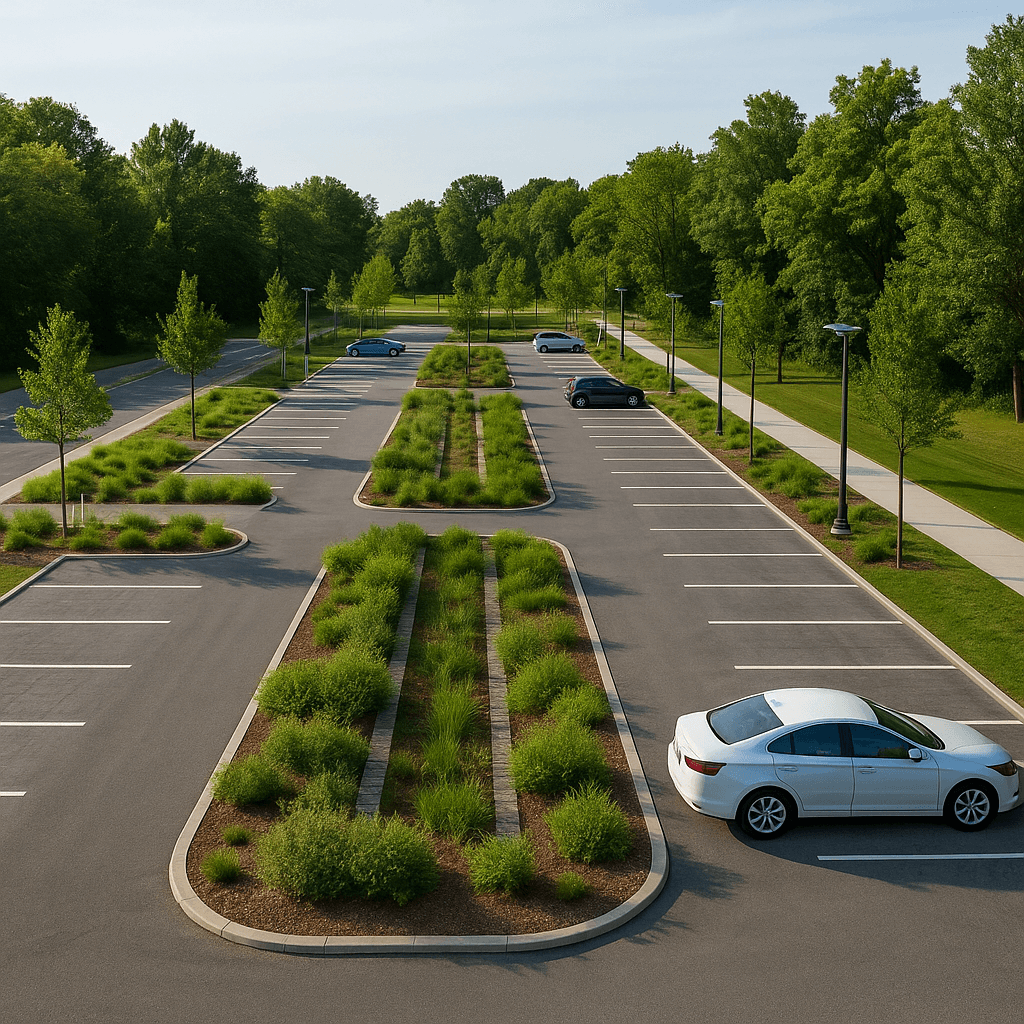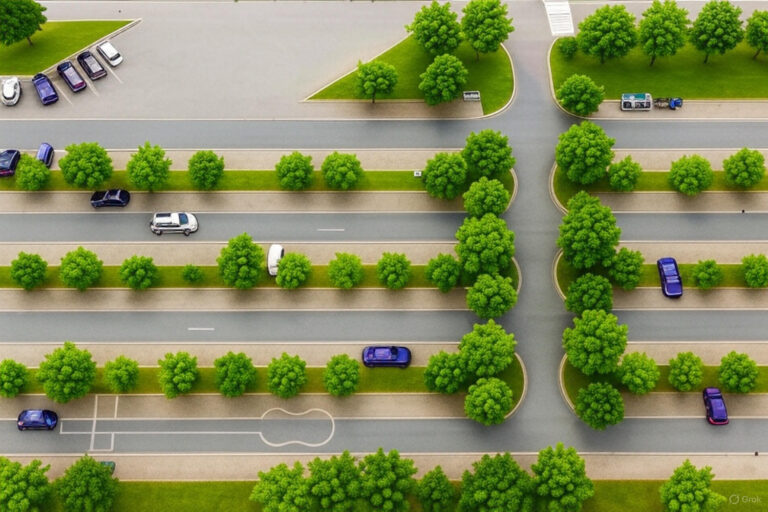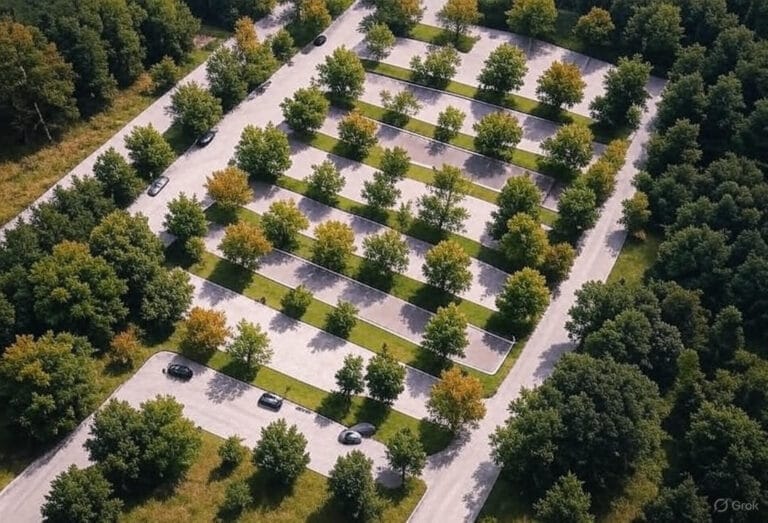
Table of Contents
ToggleGreen parking lots as future
Over many years parking lots have been one of the most ignored and environmentally damaging parts of urban infrastructure. They are often made with impermeable Asphalt or concrete and these materials absorb heat, causing flooding easily during storms and contribute nothing to urban ecology. The rise of green parking lot design and structure enabled urban spaces to fight climate change, reduce pollution and bring nature back into the city.
This shift isn’t just about aesthetics. As cities are facing many environmental problems like heatwaves, flooding and vanishing biodiversity, utilitarian infrastructure like parking areas must also evolve. From bioswales and Rain gardens to permeable Pavers and native plant buffers cities are embracing new materials. In this blog we will learn about green parking lot design, its benefits and a real example.

Green parking lot design features
1. Permeable Pavements (Natural filters)
Traditional Asphalts do not allow rainwater to pass through the surface into a gravel or soil layer below. But permeable pavers counter this problem, as they allow water to pass into the gravel or soil layers. This reduces runoff, filters pollutants and replenishes groundwater.
Cities like Toronto and Portland now use multilayered permeable systems that store runoff temporarily during heavy storms which helps to prevent downstream sewer overflows. Install Urban bee hotels on your bench
2. Bioswales (clean and guide stormwater)
These vegetated channels run between or alongside parking rows and capture runoff. But they don’t just slow water they also clean it through soil filtration and plant uptake. Design advantage : By using deep-rooted native grasses and sedges designers can boost pollutant absorption while requiring less maintenance than traditional turf. Sponge rooftops city.
3. Integrated Tree Islands
People often isolate plants. But instead of isolating them, green parking lot design embeds tree islands across all the areas (often every 4-6 spaces) by using structural soil beneath the pavement. This allows roots to spread without cracking concrete. Some urban designs also include tree trenches that connect multiple islands underground which helps to improve both canopy growth and stormwater capture.
4. Solar Canopies over Parking Bays
A growing trend in tier 1 cities is installing solar panels on stop carports. These generate clean energy, provide shade and extend EV charging infrastructure. When it’s combined with permeable surfaces below it creates a high-performing dual climate strategy that reduces both surface heat and fossil fuel reliance.
5. Native plant buffer zones
In green parking lot design native plant buffer zones are added instead of walls or fences. Native shrubs, and tall grasses form living edges that block noise, attract pollinators and filter pollutants. These buffer zones also act as visual cooling barriers which reduce the perceived heat for pedestrians and nearby buildings.
6. EV-ready with green charging Bays
Charging stations are now integrated with shaded and vegetated areas to reduce heat stress on EV batteries and users. Some Green parking lots cool these areas using the Evapotranspiration zone which are shallow planted beds beside each charger that lower the ambient temperature.
7. Zones layouts for shared Mobility
Install Zones layouts for shared mobility and bicycles. Instead of feeling all spaces with cars, green parking lots reserve zones for e-bikes scooters and rideshares, reducing total car dependency. The city of Oslo now requires all new public lots to include at least 20% area for non-car mobility and green infrastructure.

Benefits of green parking lots
Green parking lot designs are often praised for how they look – sleek, leafy and modern. But their true value lies deeper like how they function within urban ecosystems, stormwater infrastructure and even human psychology. Know about the Urban Wildflower meadow.
1. Parking lots as passive runoff infrastructure
So instead of just installing expensive underground drains these green parking lots naturally absorb and filter runoff. Permeable paving, rain gardens, bioswales and tree trenches all slow down water, reduce peak runoff by up to 90% and recharge local aquifers. As you know climate climate-induced flash floods are rising in US cities like Houston and Miami, hence turning parking lots into sponge-like surfaces is no longer optional.
According to EPA – Green Infrastructure Environmental Benefits, Strategically placed vegetation can reduce surface temperatures on sunny summer days by 20–45°F.
2. Reduces the urban heat island
Standard black top lots absorb massive amounts of solar radiation. In contrast, green lots with light-colored permeable paving, vegetated buffers and shade trees stay significantly cooler. They are often up to 20 – 30°F lower than asphalt. So less heat equals less demand for surrounding AC units which decreases energy consumption.
3. Improve local air quality around commuter hubs
When green infrastructure is strategically placed, it filters out airborne particulates from cars and trucks. Bioswales and densely planted tree rows near parking zones reduce PM2.5 by 15-25% and especially in transit adjacent parking areas. Park and ride lots in Los Angeles County have started adding tree canopies and buffer planting for this reason.
4. Enhances public perception and Retail footfall
According to multiple retail design studies, Shoppers in greener lots linger longer and feel safer. Shoppers were 11% more likely to return to retail zones with shaded and landscaped parking over traditional blacktop lots. For mixed-use development, this boosts not just sustainability ratings but revenue too.
5. Provide Micro Habitats
Pollinator gardens and native ground cover in parking zones support urban bees, birds and even beneficial insects. It won’t replace wild habitat Despite this green parking strip can host over 15 native plant species for 100 square feet in the right design. Insect diversity in green parking medians can be as high as City Parks especially if native underplanting is done right.
6. Improves Mental Well-Being
Even short exposure to Green parking environments (as little as 5 minutes) leads to measurable reductions in stress indicators like blood pressure and heart rate. Hospital, school and library parking areas are now being redesigned with the exact goal.
According to a USGS study, permeable pavement reduces pollutant loads during a 24-month monitoring period, with total suspended solids reduction is up to 80% (for pervious concrete), 69% (interlocking pavers), and 65% (porous asphalt).

Challenges of eco friendly parking lot
Higher up-front Costs
When you are installing permeable Pavements, bioswales, tree trenches and solar infrastructure it increases the initial cost compared to standard Asphalt lots. But many cities have overcome it. Cities like Portland and Philadelphia offer stormwater fee reduction and green infrastructure grants to offset capital costs for private developers. Public-private partnerships and green bonds are also emerging as long-term financing models that help green initiatives.
Limited Technical knowledge
Green infrastructure demands specialised design and maintenance knowledge especially for bioswales, infiltration beds or native vegetation integration. Yet many contractors fall behind in terms of knowledge. Training workshops and certification programs are being launched for landscape architects civil engineers and contractors. Cities published cool parking lot design manuals to standardized practices.
Maintenance Misconceptions and Neglect
There is a commonality that green parking lots are maintenance-free. And this misconception leads to clogged pavements, dead plants or poorly functioning bioswales. Many cities now include performance-based maintenance contracts in their planning. Technology like vacuum sweepers for porous pavement or remote moisture sensors for bioswales is being deployed to optimize upkeep.
Space constraints for sustainable parking solutions
In tight urban zones, adding bioswales, trees or large infiltration beds can reduce total parking capacity. What cities can adapt multi-use design means – Tree trenches along parking edges or bioretention islands between stalls that don’t eat into car space. Structured green parking is used in place of horizontal sprawl.
Zoning barriers for cool parking lots
Updated parking leads to minimum and rigid zoning codes that can block the inclusion of green features or limit innovation in lot layout. To counter this issue – form-based codes are being adopted in cities like Miami and Denver to support flexible green parking lot design. Stormwater credits and zoning overlays help developers to meet sustainability goals without breaking code.
FAQs
Are green parking lots more expensive than traditional one ?
Yes the initial cost of a green parking lot is usually higher due to materials like permeable pavers, bioswales and underground water management systems. However they offer long-term savings through reduced stormwater fees, lower maintenance and extended pavement life.
What materials are used in green parking lot design ?
It includes –
- Permeable concrete or porous asphalt
- Permeable interlocking pavers
- Vegetated swales and rain gardens
- Recycled materials ( crushed concrete, rubber pavers)
Do green parking lots help with local flooding issues ?
Absolutely. Green parking lot design significantly reduces surface runoff which helps to prevent localised flooding during heavy rains. For example, USGS research shows that a permeable Pavement system can infiltrate up to 100 % of rainfall during many storm events.
